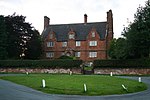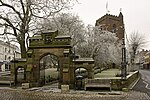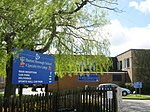Forton, Staffordshire

Forton is a small village and civil parish in Staffordshire, England, situated east of the market town of Newport, Shropshire. The civil Parish population at the 2011 census was 308. It is situated around Forton Hall and the 14th century All Saints church, and is sited on the Roman road Via Devana and the modern A519 road between Newport and Newcastle-under-Lyme. Forton Hall was built by Edwin Skrymsher of Norbury Manor, Eccleshall, at the end of the 17th century and is situated adjacent to the church of All Saints. In 1729 five new bells were given to the church. The most prominent monument is the alabaster tomb of Thomas Skrymsher (died 1633), knight of Aqualate and his family. There is a pub called The Swan.
Excerpt from the Wikipedia article Forton, Staffordshire (License: CC BY-SA 3.0, Authors, Images).Forton, Staffordshire
A519,
Geographical coordinates (GPS) Address Nearby Places Show on map
Geographical coordinates (GPS)
| Latitude | Longitude |
|---|---|
| N 52.788 ° | E -2.367 ° |
Address
A519
TF10 8BZ
England, United Kingdom
Open on Google Maps








